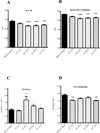Increased phospholipase A2 and lyso-phosphatidylcholine levels are associated with surfactant dysfunction in lung contusion injury in mice
- PMID: 22853859
- PMCID: PMC3509248
- DOI: 10.1016/j.surg.2012.05.043
Increased phospholipase A2 and lyso-phosphatidylcholine levels are associated with surfactant dysfunction in lung contusion injury in mice
Abstract
Objective: Surfactant dysfunction is an important pathologic disturbance in various forms of acute inflammatory lung injury. Previously we reported the presence of marked alterations in the composition and activity of pulmonary surfactant in bilateral lung contusions (LC) injury induced by blunt trauma in rats. This is extended here to a mouse model of unilateral LC with a focus on compositional and functional changes in surfactant associated with permeability injury and increases in activity of secretory phospholipase A2.
Results: Surfactant-associated gene expression was not altered in mice with unilateral LC injury on the basis of Affymetrix analysis. LC mice had significant permeability injury with increased albumin and total protein in bronchoalveolar lavage at 5, 24, 48, and 72 hours after insult compared with uninjured controls. The percent content of large surfactant aggregates was depleted at all postinjury times, and pulmonary pressure-volume (P-V) mechanics and compliance were abnormal during this period. Surfactant dysfunction was evaluated in 24 hours, when permeability injury and P-V changes were most prominent. At this time, activity levels of secretory phospholipase A2 were increased in bronchoalveolar lavage, and chromatographic analysis showed that large surfactant aggregates had decreased levels of phosphatidylcholine and increased levels of lyso-phosphatidylcholine. These changes were accompanied by severe detriments in large aggregate surface activity by pulsating bubble surfactometry. Large aggregates from LC mice at 24 hours had minimum surface tensions of only 12.6 ± 1.1 mN/m after prolonged bubble pulsation (20 min) compared with 0.7 ± 0.03 mN/m for uninjured controls.
Conclusion: These results document important detriments in the composition and activity of pulmonary surfactant in LC injury in mice and suggest that active synthetic phospholipase-resistant exogenous surfactants may have utility in treating surfactant dysfunction in this clinically important condition.
Copyright © 2013 Mosby, Inc. All rights reserved.
Figures






Similar articles
-
Surfactant dysfunction in lung contusion with and without superimposed gastric aspiration in a rat model.Shock. 2008 Nov;30(5):508-17. doi: 10.1097/SHK.0b013e3181673fc5. Shock. 2008. PMID: 18323743 Free PMC article.
-
Generation of lyso-phospholipids from surfactant in acute lung injury is mediated by type-II phospholipase A2 and inhibited by a direct surfactant protein A-phospholipase A2 protein interaction.J Clin Invest. 1998 Sep 15;102(6):1152-60. doi: 10.1172/JCI3236. J Clin Invest. 1998. PMID: 9739049 Free PMC article.
-
Local effect of lung contusion on lung surfactant composition in multiple trauma patients.Crit Care Med. 1999 Aug;27(8):1441-6. doi: 10.1097/00003246-199908000-00005. Crit Care Med. 1999. PMID: 10470747
-
Lung contusion: inflammatory mechanisms and interaction with other injuries.Shock. 2009 Aug;32(2):122-30. doi: 10.1097/SHK.0b013e31819c385c. Shock. 2009. PMID: 19174738 Free PMC article. Review.
-
The serpentine path to a novel mechanism-based inhibitor of acute inflammatory lung injury.J Appl Physiol (1985). 2014 Jun 15;116(12):1521-30. doi: 10.1152/japplphysiol.00246.2014. Epub 2014 Apr 17. J Appl Physiol (1985). 2014. PMID: 24744383 Free PMC article. Review.
Cited by
-
Polymer Lung Surfactants Attenuate Direct Lung Injury in Mice.ACS Biomater Sci Eng. 2023 May 8;9(5):2716-2730. doi: 10.1021/acsbiomaterials.3c00061. Epub 2023 Apr 20. ACS Biomater Sci Eng. 2023. PMID: 37079432 Free PMC article.
-
Evolution of interfacial mechanics of lung surfactant mimics progression of acute respiratory distress syndrome.Proc Natl Acad Sci U S A. 2023 Dec 19;120(51):e2309900120. doi: 10.1073/pnas.2309900120. Epub 2023 Dec 12. Proc Natl Acad Sci U S A. 2023. PMID: 38085774 Free PMC article.
-
Tuberous sclerosis complex 2 loss increases lysophosphatidylcholine synthesis in lymphangioleiomyomatosis.Am J Respir Cell Mol Biol. 2015 Jul;53(1):33-41. doi: 10.1165/rcmb.2014-0379RC. Am J Respir Cell Mol Biol. 2015. PMID: 25780943 Free PMC article.
-
[The Use Of Pulmonary Gene Therapy In The Treatment Of Experimental Models Of Pneumonia And Septicemia].Gac Med Caracas. 2018 Mar;126(1):5-14. Gac Med Caracas. 2018. PMID: 30100668 Free PMC article. Spanish. No abstract available.
-
Alveolar macrophage depletion increases the severity of acute inflammation following nonlethal unilateral lung contusion in mice.J Trauma Acute Care Surg. 2014 Apr;76(4):982-90. doi: 10.1097/TA.0000000000000163. J Trauma Acute Care Surg. 2014. PMID: 24662861 Free PMC article.
References
-
- Cohn SM. Pulmonary contusion: review of the clinical entity. J Trauma. 1997;42:973–979. - PubMed
-
- Lewis FR. Thoracic trauma. Surg Clin North Am. 1982;62:97–104. - PubMed
-
- Miller PR, Croce MA, Bee TK, et al. ARDS after pulmonary contusion: accurate measurement of contusion volume identifies high-risk patients. J Trauma. 2001;51:223–228. discussion 9-30. - PubMed
-
- DePalma RG, Burris DG, Champion HR, Hodgson MJ. Blast injuries. N Engl J Med. 2005;352:1335–1342. - PubMed
-
- Ketoconazole for early treatment of acute lung injury and acute respiratory distress syndrome: a randomized controlled trial. The ARDS Network. JAMA. 2000;283:1995–2002. - PubMed
Publication types
MeSH terms
Substances
Grants and funding
LinkOut - more resources
Full Text Sources
Other Literature Sources
Medical

